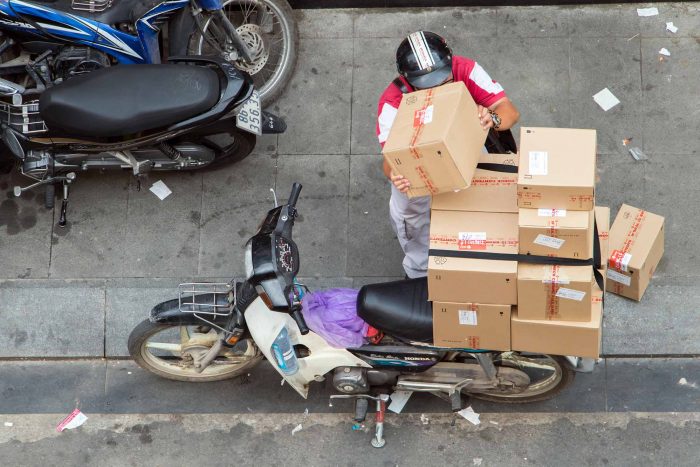Delivery time: Australia’s opportunity to take a Go-Jek ride

The tech boom offers the possibility of a more comprehensive economic relationship with Asia.
There is little that is novel about the rise of Asia amongst Australian audiences. Australia has spent decades attempting to come to grips with the relative repositioning of its neighbours. It has encouraged its students to learn Indonesian, Mandarin, Japanese. It has brought Asia’s talent to its shores to study. Australia has spent billions on aid in its region and produced its own tome on the Asian Century. It has grappled with the geopolitical growth of its region like few other nations.
There is much to show for these efforts, not least the depth of public awareness and the erudition of our political understanding about the epochal changes unfolding to Australia’s north. We have built a very healthy trade in primary exports and more recently combined it with a huge serve of educational services exports. There is much of which Australians can be pleased.
Nevertheless, Australia, and particularly its companies, are failing to comprehend the extent of change being wrought in our region and the impact this will have particularly within the commercial sphere. In general, business understanding of the Asian Century is about as vague as the term used to describe it. Companies know there will be more consumers and more money, but they have struggled to build an enduring presence beyond the routine dispatch of primary products.
There will always be money selling food and resources, but unless Australia rapidly advances to a more sophisticated engagement with Asia – both in terms of the goods we trade and in the type of engagement we have with the disparate regions of this vast area, particularly South-East Asia – we risk the prospect of forgoing the region’s economic metamorphosis, and the high-value, high-skilled jobs that will be created by it.
That Old Chestnut
Disruption is a hackneyed term in 2018, but it does deserve its application when describing the surging upheaval of Asia’s political economy. Most Australians are familiar with the historical plot line of this story, which describes the emergence of China after the 1978 economic reforms and the ensuing four decades of 10 per cent average annual GDP growth.
No country in history has undertaken such a dramatic rise in affluence, and newfound Chinese riches have in turn created the demand that is felt in Australia’s mines, on its farms, and in its universities and tourist destinations. China now boasts the world’s largest economy by purchasing power parity (PPP) and its growth outpaces its only global superior, the United States, meaning that at current rates China will also have the largest economy at market GDP in the next 20 years. In other metrics, like manufacturing output or exports, China leads handsomely in spite of the efforts of the Trump Administration.
Australians have been dazzled by the brilliance of China’s economic miracle. So much so that Asia often means China in Australia: “Asia experience” connotes a one-year stint in the Shanghai office of a multinational or if you are yet to delete your dormant Wechat account from your iPhone. This is a mistake. For although no country rivals China’s in growth and endurance, the post-war revival of Japan, the economic miracle of the Asian Tigers, and the unshackling of the Indian License Raj are all critical plot lines in the tale of Asia’s rise. As is, perhaps more visibly for Australians, the emergence of ASEAN. It is here, in its immediate north, that Australia is presented with its greatest opportunity.
Knowing nasi goreng
In 1970 most ASEAN member states had barely emerged from the agrarian shadow cast by colonialism, and together their economies made up just $37.6 billion in GDP. Australians returning on the hippy trail from London could still lie untroubled on the quiet sands of Kuta recuperating from their excesses. Today, the United Kingdom’s economy is equivalent in size to a combined total of the ASEAN members or US$2.6 trillion. Australian tourists flock in the millions to resorts in Indonesia, Vietnam, Thailand, and the Philippines, staying in five star hotels or villas booked on AirBNB.
But it is one thing to know nasi goreng and quite another to have meaningful engagement. Successive Australian governments have understood this, and they have tried commendably to push greater integration with the region, through studies and scholarships and expansive foreign aid programs. Maybe all of this has been to compensate for the reluctance of the private sector. It is as if by teaching Australian students Korean we might miraculously engender a meaningful trade relationship. The reality is that in spite of all the efforts at getting to know Asia, Australians remain largely ignorant of how to trade with it.
On the sheep’s back
When I interviewed a senior Australian businessman for this piece, he told me I was wrong to hold this view and that in fact Australia was investing at a rate and scale appropriate for its size. Australian banks, resources companies and family offices were all active across the region. They were investing a wide range of assets, including technology, in China, in South-East Asia, in India. Australia’s problem was not investment, it was narrative: a parochial strand of Australians was acting as a handbrake on the nation’s economic integration with the region.
His argument deserves careful consideration. After all, Australia’s largest export partners are all in the region with East Asia taking a combined 60 per cent of Australia’s exports. China alone accounts for 30 per cent of our outbound trade, while ASEAN receives a further 11.6 per cent. It is not just the amount of goods that Australia sends north, but the solid, tangible nature of our exports that makes our trade relationship with Asia feel sturdy. We send coal and gold and even vegetables. But the gist remains the same: resources and primary products to feed the growth of the developing north.
This is good news for Australia because the general trend of history has been that as people get richer they build bigger houses and eat more meat. That translates to ongoing demand for Australian exports. Projections from the Asia Development Bank suggest that the continuation of Asia’s current growth rates across the next 30 years would result in a sixfold increase in purchasing power and three billion additional affluent Asian people by 2050. Other forecasts offer a similarly comforting view for Australia’s chief exporters. China, for example, is projected to account for 43 per cent of growth in demand for agricultural products all the way until 2050. All in all, it amounts to a lot of beef, dairy and iron ore.
Australians, then, have reasonable cause to expect ongoing demand for our primary goods, even in the face of a few very plausible hiccups along the way. The ensuing US-China trade war, disputes over the South China Sea, worsening climate conditions, the fabled ‘middle income trap,’ and even the prospect of changes to construction materials and consumer tastes – residents of Asia may turn out to prefer almond milk lattes – all spring to mind. But even the ructions of recent history have not substantially impeded the advance of global growth.
1-hour “Guaranteed Delivery” in Jakarta
Australia has enjoyed a comfortable ride on the sheep’s back and with any luck this contented pastoral journey will continue. But this is hardly a national strategy. To maintain its position amongst the world’s most affluent nations, Australia must create and scale globally-competitive technology companies and use its privileged position in Asia to deploy and export these technology products to the region. Achieving this outcome will require a collective acknowledgment about the scale of commercial upheaval that is being rendered by the technology industry, a readjustment of mindset about the opportunities for technology companies in the region, and the successful cultivation of a powerful, home-grown technology industry.
The Australian business community needs first to comprehend the scale of change that technology is having in Asia. Indonesia provides a stark example, where until recently tens of millions of consumers languished within a traditional, informal economy. As recently as 2011, the Indonesian technology scene amounted to little more than a grab-bag of online forums and classifieds. Today it is serviced by some of the most well-funded ecommerce businesses on the globe. In the three years since 2015, more than $2.5 billion has poured into Indonesian tech companies – and online shoppers in Jakarta, already enjoy a one hour delivery guarantee on leading sites (against a laggardly three hour promise in Sydney).
The effect of these investments is not simply to put Indonesia on an equivalent footing with its richer neighbours. Guided by the strategy and experience of Chinese companies, leading ecommerce and ride-hailing companies are providing unprecedented access to goods and services into the far reaches of the archipelago and disrupting incumbents in financial services, transport and retail.
Take South-East Asian ride-hailing company Grab, which last year acquired Kudo, an Indonesian business that provides 1.4m traditional sellers with a software platform to manage their sales of goods and services. The acquisition constitutes part of a two-pronged strategy to digitise and capture once informal sales via the Kudo network, while providing a digital wallet for consumers via Grab’s app which then allows consumers to buy not just their daily transport but an extended range of digital goods and services. If Grab is able to stimulate its customers to deposit into a digital wallet in order for them to buy a range of goods and services, it is in effect threatening the core deposit-taking banking system and all downstream retailers that provide similar goods to those offered in the Grab ecosystem.
Money talks
Grab is not alone in pursuing this strategy or some version of it. Other ride-hailing competitors like GoJek and the portfolio of companies that have received investment from Alibaba and its payment arm, Ant Financial, are all attempting to enclose consumers in a comprehensive, seamless ecosystem of goods and services that threatens to radically upset existing businesses within these industries. And they are doing it everywhere. With Alibaba, Ant Financial, Grab, Lazada, JD.com a slew of recently-born Asian tech companies are rapidly reaching into the far corners of the continent to capture billions of consumers that until recently were mostly just considered as a prospective opportunity for global commerce.
There is little evidence to suggest Australian business has recognised the opportunity presented by these genuinely disruptive companies, unlike Chinese tech companies which are clearly forecasting that the experiences of China’s internet boom in the decade from 2007 will be repeated across India and South-East Asia. Nor is it just the Chinese. A swag of savvy investors from Japan, Korea, Singapore and even some Americans have drawn the same conclusion. Collectively, they are pouring billions into South-East Asia’s technology boom. They do not have an Australian peer. “Somehow I’ve never heard of a big Australian spending money in South-East Asia,” Kudo co-founder Agung Nugroho told the Australian Financial Review when he was visiting Sydney recently.
At least Australians can seek solace – and example – in the achievements of our technology ecosystem’s leading light, Atlassian. The company’s core product, Jira, a software development tool, is used by engineering teams across the region: a high-value, high-skill product that is created in Australia and is providing a core functionality to Asia’s tech boom. Atlassian’s success provides ample evidence that Australia can build and scale globally-competitive technology companies and it should be the collective focus of federal and state governments to create the conditions that will enable more of such companies to develop.
Australia is well positioned to enjoy the Asian Century and we will likely still enjoy some of its benefits even if we continue to sell our iron ore and periodically take a punt on something bigger. But there is an opportunity to be part of a momentous period of disruption and to benefit from it we must abandon the tepid response it has so far been accorded. Australian capital must be mobilised into the deals that competitor nations’ financiers are finding appealing. We must agree on a shared national vision to make Australia the jumping-off point for Western companies into Asia while at the same time promoting the ASX as an easy, compelling exchange on which Asian tech companies can list. After all, as Agung remarked, “Australia has a good story to tell. It is only a direct flight away and Atlassian is based here. Singapore doesn’t have a billion-dollar tech business.”













